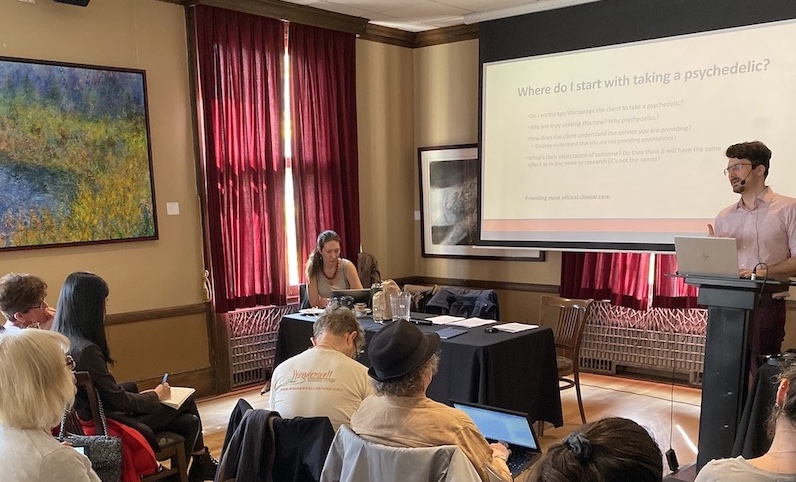Popular classes on how to be a trip sitter range from virtual courses, like “Foundations in MDMA and Psilocybin Safety”, to in-person retreats that can cost thousands of dollars. Whew! So, are they worth checking out? Or are is it just another fad?
Would you attend shaman school? Let’s take a closer look!
The New Gold Rush
Julie Holland, psychiatrist and author of “Good Chemistry: The Science of Connection, From Soul to Psychedelics”, first noticed the growing trend of shaman schools in the U.S.
“It’s like a gold rush. The green rush for cannabis happened over decades. But for psychedelics it’s happening over a few months.”
It’s probably partly due to the recent wave of decriminalisation, which started in Oregon and Washington, D.C. and shows no sign of stopping. However, it’s not yet legal for U.S. health workers to use this kind of psychedelic on patients.
This is why for now, rather than the clinical aspects (which would require medical training), shaman schools are looking more into the “trip-sitting” side of things. Like how to take care of patients before and after a trip, in a special method known as “psychedelic integration”.
Fluence
One such school for shamans, Fluence, got a major boost in revenue last year. Seven times (!) their usual profit. But co-founder Ingmar Gorman won’t say much about his golden secret, other than that they charge $550 to $1,200 per course.

Apart from their virtual courses, aspiring shamans at Fluence can opt for a $7,450 in-person retreat. The entire program is held at the Catskill Mountains in New York. It’s far enough from the ‘city that never sleeps’ that the social workers & therapists can master the art of trip-sitting in perfect harmony with nature. But there’s no pressure to try psychedelics, says Gorman.
“Clinicians are not recommending psychedelics, but rather supporting the autonomy of patients who might, for example, go to Peru for an ayahuasca ceremony.”
Since being founded in 2019, Fluence has enrolled over 640 students, with more than half of them social workers or psychologists. The rest of them are therapists or medical providers, coaches, engineers, lawyers, and even priests!
“Psychedelics put people in a very vulnerable state, and that’s why this training is so important.”
Psychedelic Somatic Institute
Just last fall on the West Coast, a shaman school called the Psychedelic Somatic Institute (PSI) opened its doors (of Perception?!) to the public. There’s a twist, however. Unlike other centers like Johns Hopkins who don’t require its facilitators to take psychedelics, at PSI it’s a necessity. Co-founder Saj Razvi explains:
“Psychedelics are such non-rational experiences. As a therapist, there’s no way to know what that’s like unless you go in yourself.”
A typical shaman course, which costs $6,200 in total, opens with 5 days of in-person classes (both in Los Angeles and Minneapolis). The rest is done online for 8 months. When you first come in, a psychiatrist will prescribe you ketamine — or you can always bring your own weed from a legal dispensary. Only after tripping will you then be allowed to take part in class therapy sessions. Sounds like a trip alright, but it really works, says Razvi:
“This particular training model is where you can get a lot of your own work done.”
Either way, the co-founder warns potential students to stay away from sketchy “experts”. This advice could be tricky to follow, though, because shaman schools are popping up like crazy in LA, dude.
“The market is huge, and it’s kind of a free-for-all, which is scary. There are training spaces on the West Coast where everyone and their mother is a shaman.
“They’ve had powerful experiences in psychedelics and assume their process is the same as others, but it’s not.”
MDMA Training at MAPS
Ask any hardcore fan of psychedelic research about MAPS, (all caps!). Chances are they’ll gush all about MAPS’ pioneering glory. From humble beginnings in 1986, to its groundbreaking studies at present, the Multidisciplinary Association for Psychedelic Studies is at the forefront of the psychedelic revolution in the scientific and medical arenas.
To this day, their most famous offering is the MDMA Therapy Training Program (costing $7,500), which has enrolled 920 students since 2012. MAPS is also responsible for cleaning up MDMA’s reputation as a “harmful” party drug. Now they’re fighting to decriminalize MDMA-based treatment for PTSD.
And with $30 million in recent donations, they might just win it.

But, if you prefer to work with MDMA as a spiritual tool, then you’re in luck. Come February 2021, MAPS will offer a 100-hour program for aspiring MDMA therapists. Expect tons of virtual retreats and exams!
No Shame in Shaman
To people who might think there’s some shame in wanting to be a psychedelic shaman, we say ‘Au contraire!’ “Shaman” may just become the raddest career in the decade to come. By then, entheogens (aka natural psychedelics) will hopefully be widely decriminalised in America. All you gotta do is pick a reliable program that best suits your needs.
Here are some other shaman schools on the rise:
- Naropa – Based in Boulder, Colorado, this Buddhist university has started offering a course in MDMA-assisted psychotherapy;

- California Institute of Integral Studies – Offers a certificate in psychedelic-assisted therapies and research;
- Compass Pathways Plc – A Wall Street favorite, whose stock blew up more than 150% since they went public last year. They also offer a core training program. Also the company the FDA likes best, if thats a concern.
It will be interesting to see how these institutions progress!
So what do you think? Would you head back to school for a new kind of education?





